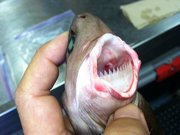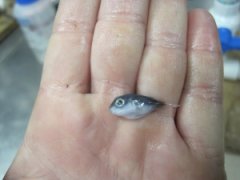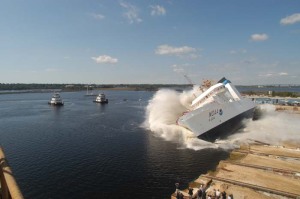NOAA Teacher at Sea
Heather O’Connell
NOAA Ship Rainier
June 7 – 21
Mission: Hydrographic Survey
Geographic Area of Cruise: Seattle, Washington to Southeast, Alaska
Date: 6/8/18
Weather Data from the Bridge: Latitude: 48.15° N, Longitude: 122 ° South 58.0’ West, Visibility: 8 nautical miles, Wind: 24 knots, Temperature: 14.2° C
Science and Technology Log
I was fortunate enough to sit in on a survey orientation for new survey technicians and junior officers with Lieutenant Steven Loy. He was on Rainier as the Field Operations Officer, F.O.O., in the past and is currently here as an augmenter filling the role of Senior Watch Officer since he has navigated through the Inside Passage several times. In his two hour orientation, he shared a wealth of knowledge and discussed how multibeam sonar and ultrasounds are two opposite ends to the ultrasonic pulse spectrum.
Multibeam sonar sends out sound and measures the time it takes to return to calculate the depth of the ocean floor. The accuracy of the depth data generated from the multibeam sonar relies on the sound speed profile of the water. The combined effects of temperature, salinity and pressure generate a sound speed profile. Because of the inherent importance of this profile, there are several different ways to measure it. The sound velocity profiler measures this right at the interface of the multibeam sonar. C.T.D.s., or conductivity temperature and depth machines, measure water profile while the ship is stopped. M.V.P.s, or moving vessel profilers, take the water profile as the vessel is moving. Lastly, XBTs are expendable bathythermographs that measure temperature while the ship is in motion.
Sound is affected by different variables as it is energy that travels through a medium as a wave. Lieutenant Loy shared an informative website, The Discovery of Sound in the Sea, where I was able to enhance my understanding. Sound can travel through a liquid, such as water, a gas like air, or a solid like the sea floor. On average, sound travels about 1500 meters per second in sea water. However, the rate changes at different times of day, various locations, changing seasons and varying depths of the water. By looking at sound speed at one particular place in the ocean, you can determine how the different variables affect this sound. Usually, as depth increases, temperature decreases, while salinity and pressure increase.
A multi-beam sensor has a metal plate receiver and a transmitter perpendicular to one another. This array geometry enhances sound. The sound velocity profiler is next to the receiver and measures right at the interface. To determine the speed of sound right where the beam is generated, sonar is used to measure speed sound across a known distance. This information is then utilized in the overall determination of the depth of the ocean floor. Once this cast is taken, the Seafloor Information System (SIS), can adjust sonar measurements accordingly.
Another way to measure the sound profile of water includes a C.T. D. This device measures the conductivity, temperature and depth of the water. Conductivity measures the electrical current of the water. The more dissolved salt, or ions in solution, the greater the conductivity and salinity of the water. The depth of the water is directly related to the pressure of the water. Salinity, temperature and pressure affect the sound speed profile of water. This machine has a high data rate that goes up and down the water column. The titanium C.T.D. operates at a high pressure and costs about forty thousand dollars. This accurate technology can only be utilized when the boat is stopped and is used on the smaller survey launches.

A third method of measuring sound profile is the M.V.P., moving vessel profiler, which takes the data when the ship is moving. These are calibrated before a survey begins and are an efficient way to collect data. An expansive crane lowers the metal torpedo with the sensor off the fantail, the overhanging back part of the ship, into the water to collect the data. The fish is programmed to stop twenty meters above the ocean floor, at which point it returns to its docked position. On ship Rainier, the deck department deploys the fish with a cable wire and the plot room with the survey technicians controls the sensor.

Another way to collect the sound profile of water with a moving vessel is to use an expendable probe. As temperature decreases, the sound speed decreases. Since temperature is the most important factor affecting the speed of sound, an X.B.T., Expendable Bathythermograph, or expendable probe created by the military. With bathy relating to depth and thermo meaning heat, this measures the temperature of the water at a cost of about one hundred dollars. These probes descend at a known rate, so, depth is a function of time.
Sources – Discovery of Sound in the Sea
Personal Log
We left port yesterday at 16:30, which has been a highlight of my NOAA Teacher at Sea Experience thus far. Before leaving port, all hands were assigned a different assignment to help with the launch. I watched the crew bring in the gangway that connects the ship to the port then disassemble it. The crew with hard hats and orange work vests took down poles and neatly tied up different sections by knotting ropes. We slowly progressed out of the port after a cargo ship passed us.

Once the ship picked up speed and the ocean breeze was in my hair, I felt a new kind of freedom. With the Seattle skyline behind us and the beautiful green peninsulas in front of us, I was content to be moving forward. Everyone seemed to feel relieved once we were underway. I felt gratitude as I enjoyed watching the sunset from the flying bridge, the area of the ship above the bridge at the front of the ship.

After sunset, I returned to my berth, or sleeping quarters, located in the bow of the ship on the C-deck. I heard the constant white noise of the propellers that got much louder when the pitch, or angle, of them changed. This sound of seawater combined with the rocking motion of the ship lulled me to sleep on our first night at sea.

Did You Know?
Juneau, the American capital of Alaska, can only be entered by plane or boat. It is inaccessible by roads due to large mountain ranges on either side.























































